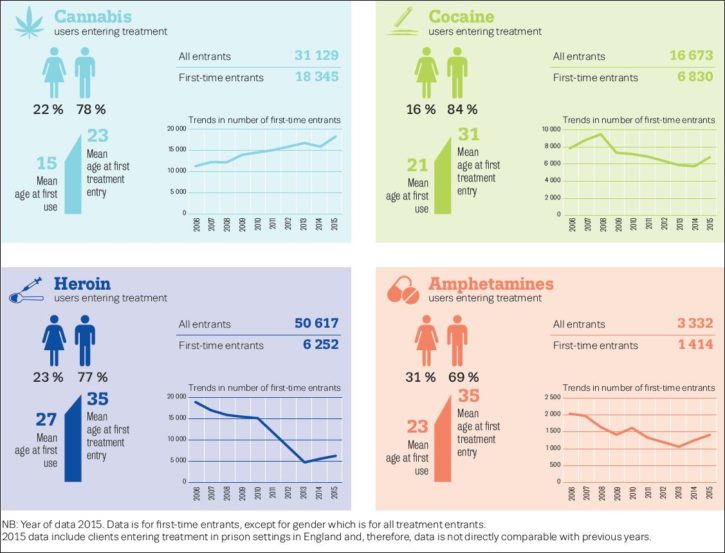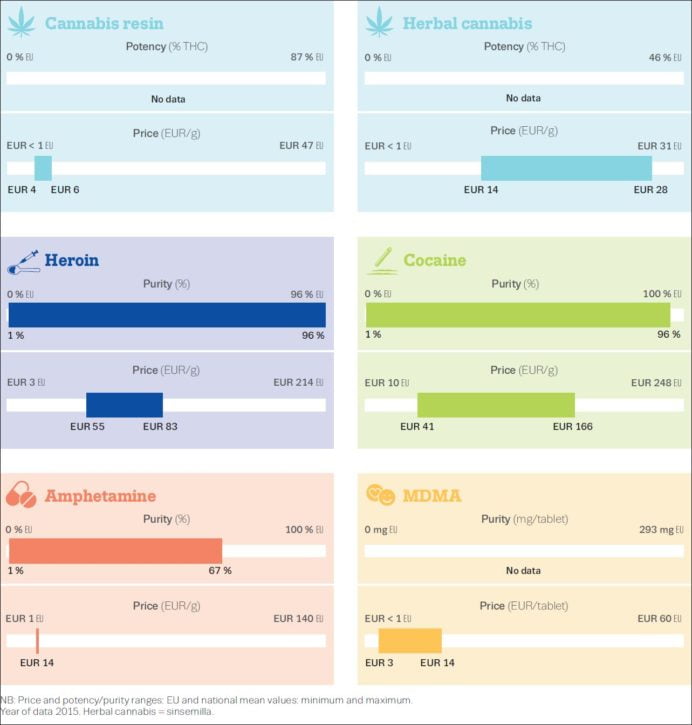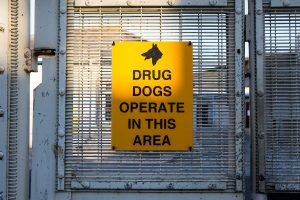The UK drug problem at a glance
Yesterday (6 June 2017) the European Monitoring Centre for Drugs and Drug Addiction published its European Drug Report for 2017 and associated country reports. This post summarises the key findings from the UK Country Drug Report 2017.
An overview of the current UK situation is provided in the graphic reproduced below:

Drug law offences
Although the report is up-to-date on such issues as the Psychoactive Substances Act, available data is from 2014 where, as you can see, 65% of offences are for drug use/possession:
Patterns of drug use
Overall, drug use in the UK has declined over the last 10 years; however, because of its relatively high prevalence, cannabis has remained a substantial driver of this overall drug trend. Cannabis remains the most commonly used illicit drug, while powder cocaine is the most prevalent stimulant in the UK and the second most prevalent drug overall, with a peak reported in 2007/08. MDMA/ecstasy is the next most commonly reported stimulant. In general, MDMA users are younger than cocaine and amphetamines users; the graphic below shows levels of use among young adults aged 16-34 years:

Drug treatment
Data on the characteristics of those entering treatment in the UK also indicate that opioids (mainly heroin) are the most commonly reported primary substances among those seeking treatment for drug use problems, followed by cannabis. Among first-time treatment clients, cannabis is the most commonly reported substance, followed by cocaine. The long-term trend indicates a steady increase in the age of opioid users seeking treatment. Recent trends in heroin treatment demand indicate that the decreasing trend reported in previous years seems to have been halted:

Harm reduction
Harm reduction intervention in the UK cover activities such as information campaigns on the risks associated with drug use; information on safer injecting and safer sex; provision of free needles, syringes and other equipment; promotion of safe disposal of used equipment; infection counselling; support and testing; vaccinations against HBV; referral to drug treatment; treatment for HIV and HCV infection; and the provision of take-home naloxone and training of drug users and their family members on its use.
The latest available estimates of the number of syringes distributed are almost 3.4 million for Wales in 2015/16, 4.4 million for Scotland in 2015/16 and almost 290 000 for Northern Ireland in 2014/15; data on syringes distributed in England are not available. The vast majority of the PWID in the UAM survey indicated that they had used needle and syringe programmes in 2015.
National naloxone programmes are implemented in Scotland, Wales and Northern Ireland; these allow the use of naloxone in non-clinical settings, such as hostels, and facilitate the distribution of naloxone kits to those at risk of overdose and to their families and carers. There still remains no national naloxone programme in England.
The UK has a targeted hepatitis B vaccination programme that is focused on the most at risk population groups, including PWID. The most recent surveys show that around three quarters of PWID report uptake of hepatitis B vaccination.
The graphic below shows how the UK compares to other European countries in the provision of harm reduction interventions:

Drug-induced deaths
Drug-induced death is the fifth most common cause of preventable death among 15- to 49-year-olds in the UK. Heroin is involved in the majority of deaths, and other drugs commonly associated with deaths from illicit substance use include benzodiazepines, cocaine and amphetamines. The drug-induced mortality rate among adults in the UK (aged 15-64 years) was 60.3 deaths per million in 2014, almost three times the most recent European average of 20.3 deaths per million:

Price and purity
The report contains an interesting graphic comparing the purity and cost of illegal drugs in the UK compared to the rest of Europe. As you can see, MDMA and heroin are relatively cheap compared to the rest of Europe, even though the general cost of living is likely to be cheaper in many of these countries:

Overall comparison
The final graphic shows how the UK compares to the rest of Europe on a number of key indicators; particularly noteworthy are our high prevalence rates for high risk opioid use, cocaine and MDMA and our troubling rate of drug-induced mortality:

Blog posts in the drug and alcohol category are kindly sponsored by Breaking Free Group which has developed a powerful and adaptable digital health platform which targets the underlying psychological and lifestyle factors that drive addictive behaviours. Breaking Free has no editorial influence on the contents of this site.







One Response
Would love to see how the UK is doing with smoking reduction thanks to their harm reduction approach. I know that Sweden is down to 5% thanks to harm reduction.